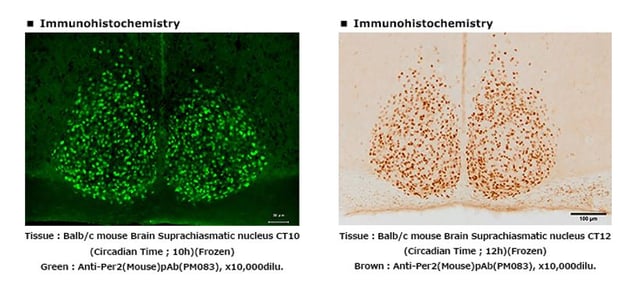Published by Tomohiro Nakajo on Sep 27, 2017 12:00:00 PM

Living organisms on the earth synchronize their activity to a 24 hour light and dark cycle generated by the rotation of the earth. This biological rhythm is called the circadian rhythm.
Recently the molecular mechanism for the oscillation of the circadian rhythm has been elucidated and the approximately 24-hour-rhythm was found to be generated by a transcription-translation feedback-loop of clock genes expressed by almost all cells. In particular, BMAL1, CLOCK, PERs and CRYs play key roles in oscillation of the circadian rhythm and rhythmically regulate the expression of downstream genes (hereinafter referred to as clock-controlled genes [CCGs]).
So far, the expression analysis of CCGs is mainly performed by mRNA quantification, like qRT-PCR and in situ hybridization. However, it is necessary to analyze protein expression level, post-translational modifications like phosphorylation, and ubiquitination for understanding the molecular mechanism of circadian rhythm. Actually, phosphorylation and ubiquitination of PER and ubiquitination of CRY are well known.
Why are these protein expression analyses not well done? The answer is very simple: because there weren't any good antibodies in this market, so we developed antibodies against CCGs.

At first we developed antibodies against PER1/2, CRY1/2, BMAL1 and CLOCK, playing core feedback loop in circadian rhythm. BMAL1 and CLOCK form a heterodimer, which binds to the regulatory region (E-box) in per1/2 and cry1/2 to positively regulate transcription. PER and CRY proteins then form a complex, migrate to the nucleus, and negatively regulate the function of the BMAL1/CLOCK complex. CCGs with E-box elements are expressed and are regulated by the BMAL1/CLOCK complex, and various genes are expressed according to circadian rhythm.
We successfully developed antibodies against all of the core feedback loop members. Anti-PER1, PER2, BMAL1 and CLOCK can be used in Immunohistochemistry (IHC), and anti-BMAL1 and CLOCK can be used for Chromatin Immunoprecipitation (ChIP) assays as well. Please be careful to choose secondary antibodies because some of the products are derived from guinea pig!
Anti-PER2 (Mouse) pAb (Code# PM083) –Rabbit Ig (Aff.)

Anti-PER1(Mouse) pAb (Code# PM091) - Guinea Pig Ig (Aff.)

Anti-CRY1(Mouse) pAb (Code# PM081) - Guinea Pig Ig (Aff.)

Anti-CRY2 (Mouse) pAb (Code# PM082) - Guinea Pig Ig (Aff.)

Anti-BMAL1 mAb (Code# D361-3)

Anti-CLOCK (Mouse) mAb (Code# D349-3)

Other antibodies related to circadian rhythm are also available.
| Code # | Product Name | Clone | Isotype | Application |
| PM091 | Anti-Per1 (Mouse) pAb | Polyclonal | Guinea Pig Ig (aff.) | WB/IP |
| PM083 | Anti-Per2 (Mouse) pAb | Polyclonal | Rabbit Ig. (aff.) | WB/IP/IH |
| PM096 | Anti-Per2 (Human) pAb | Polyclonal | Guinea Pig Ig (aff.) | WB/IP |
| PM081 | Anti-Cry1 (Mouse) pAb | Polyclonal | Guinea Pig IgG | WB/IP |
| PM082 | Anti-Cry2 (Mouse) pAb | Polyclonal | Guinea Pig IgG | WB/IP |
| D361-3 | Anti-BMAL mAb | 2F11 | Mouse IgG1 κ | WB/IH |
| D335-3 | Anti-BMAL (Mouse) mAb | B1BH2 | Mouse IgG1 κ | WB/ChIP* |
| D349-3 | Anti-CLOCK (Mouse) mAb | CLSP4 | Mouse IgG1 κ | WB/IP/IH/ChIP* |
| D333-3 | Anti-CLOCK (Mouse) mAb | CLSP3 | Mouse IgG1 κ | WB/IP**/ChIP* |
| D334-3 | Anti-CLOCK (Mouse) mAb | CLNT1 | Mouse IgG1 κ | WB/IP* |
| PM087 | Anti-Chrono (Mouse) mAb | Polyclonal | Rabbit Ig (aff.) | WB |
| PM079 | Anti-DBP (Mouse) pAb | Polyclonal | Rabbit Ig (aff.) | WB/IF |
| PM097 | Anti-NFIL3 (E4BP4) pAb | Polyclonal | Rabbit Ig (aff.) | WB |
| M225-3 | Anti-NFIL3 (E4BP4) chimeric mAb | 42 | Guinea Pig Ig κ (chimeric) | WB/IP/FCM/IH |
| PM093 | Anti-NR1D2 (Rec-erbß) pAb | Polyclonal | Guinea Pig Ig (aff.) | WB/IP |
| PM092 | Anti-NR1D1 (Rev-erbα) pAb | Polyclonal | Rabbit Ig (aff.) | WB/IP |
| PM075 | Anti-GNAT2 (Zebrafish) pAb | Polyclonal | Rabbit Ig (aff.) | WB/IF |
| *The use is reported in a research article (Not tested by MBL). Please check the datasheet for detailed information. |
| **The use is reported from the licenser (Under evaluation or not tested by MBL). |
As described above, many CCGs are taking various post-translational modifications, and it becomes clear that these modifications are important to regulate oscillation of the circadian rhythm.
We hope our antibodies help you to elucidate spatiotemporal modification of CCGs, and become 'good antibodies'!